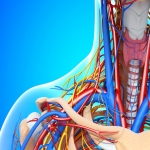Let Us Help You Decide
Numbness and tingling in the hands can be an annoyance, or even a painful situation for some. Unless you have an underlying condition that causes numbness, such as diabetic neuropathy or fibromyalgia, it is likely that you have nerve compression affecting that limb. In this blog, we will take a look at two very different types of nerve compression: Thoracic Outlet Syndrome and Carpal Tunnel Syndrome.
Thoracic Outlet Syndrome
What Is It?
 Thoracic Outlet Syndrome is a classification of conditions affecting the nerves at the space between your collar bone and your first rib. This is most commonly caused by either physical trauma, anatomical defects (extra rib), or pregnancy. Often, an underlying factor cannot be identified, which makes diagnosis difficult and at times wrong.
Thoracic Outlet Syndrome is a classification of conditions affecting the nerves at the space between your collar bone and your first rib. This is most commonly caused by either physical trauma, anatomical defects (extra rib), or pregnancy. Often, an underlying factor cannot be identified, which makes diagnosis difficult and at times wrong.
There are three main types of Thoracic Outlet Syndrome:
- Neurogenic: compression of the brachial plexus, the bundle of nerves that originates at the spinal cord.
- Vascular: compression of the arteries or veins that travels between the collar bone and first rib
- Non-specific: this is believed to present with chronic pain in the area of the thoracic outlet that increases with activity, though a specific cause of pain is not able to be determined.
Signs and Symptoms
- Abnormal color in the hand
- Discomfort and inflammation in the arm or hand
- Pale fingers or hands
- Diminished pulse
- Cold hands, fingers, or arms
- Numbness and tingling in the hands
- Throbbing lump near the collar bone
Diagnosis and Treatment
Quite often, it is difficult to determine a diagnosis of TOS due to symptoms being so varied among patients. Physical examination along with obtaining a medical history is usually the first step. Imaging or nerve study tests may be done as well to look for anatomical abnormalities or to test the function of your nerves or arteries.
Physical therapy and anti-inflammatories are often the first step for management of symptoms. Learning to maintain proper posture can help open the area of compression and alleviate symptoms. Surgery is only considered after failure to see results with conservative methods. Unfortunately, the risk of complications, ineffectiveness of surgery, or recurrence of symptoms are all possible.
Carpal Tunnel Syndrome
What Is It?
 Carpal tunnel syndrome is a condition in which there is mechanical compression to the median nerve that runs through the palm side of the wrist and hand. This compression causes numbness and tingling in the hand, primarily in the thumb, index, middle, and part of the ring finger.
Carpal tunnel syndrome is a condition in which there is mechanical compression to the median nerve that runs through the palm side of the wrist and hand. This compression causes numbness and tingling in the hand, primarily in the thumb, index, middle, and part of the ring finger.
Signs and Symptoms
- Numbness and tingling
- Burning pain
- Shocking sensations in the hand
- Pain that radiates up the forearm to the shoulder
- Weakness and dropping things
- Trouble with fine motor skills
Diagnosis and Treatment
 Obtaining a medial history and performing a physical examination to reproduce symptoms can help determine the location of the underlying nerve compression. Often, there is muscle atrophy (decreased size of the muscle) in the hand, along with physical symptoms that occur with certain physical tests.
Obtaining a medial history and performing a physical examination to reproduce symptoms can help determine the location of the underlying nerve compression. Often, there is muscle atrophy (decreased size of the muscle) in the hand, along with physical symptoms that occur with certain physical tests.
A battery of tests exists to help diagnose compression of the nerve, including EMG (electromyogram), NCS (nerve conduction studies), ultrasounds, or MRI tests. The main objective of these tests is to measure the health of the nerves, determine the location of compression of the nerve, or to identify alternative pathologies that can cause similar symptoms.
In the early stages of carpal tunnel syndrome, splinting, anti-inflammatories, activity modification, or cortisone injections can all help relieve symptoms. Unfortunately, the only way to stop the nerve’s health from worsening is to release the mechanical compression of the nerve with a simple surgery. The risk of reoccurrence of carpal tunnel syndrome after release is low and there are minimal complications that could follow surgery.
If you suspect that you have some type of nerve compression, one of our qualified specialists is ready to evaluate you and your treatment needs.
Related Physicians
The providers at Kansas City Bone and Joint Clinic each have their own areas of specialty. Click on the providers below to read more about them.




